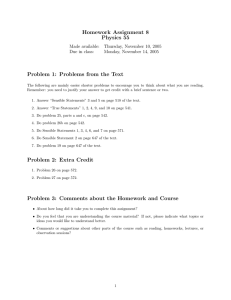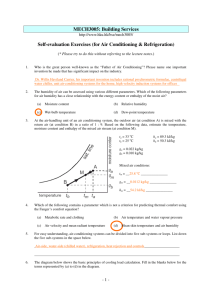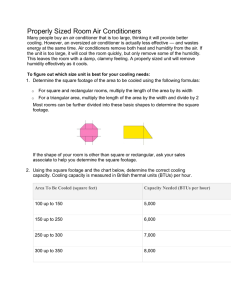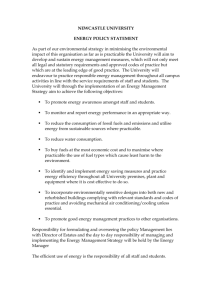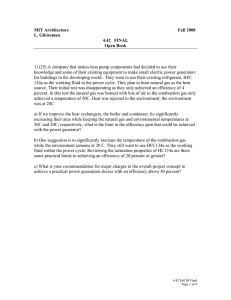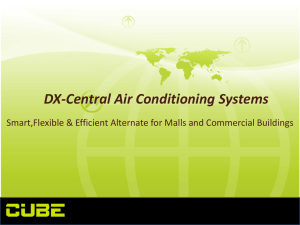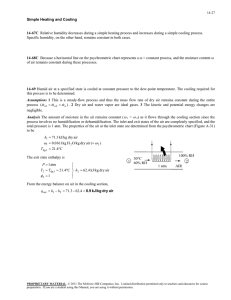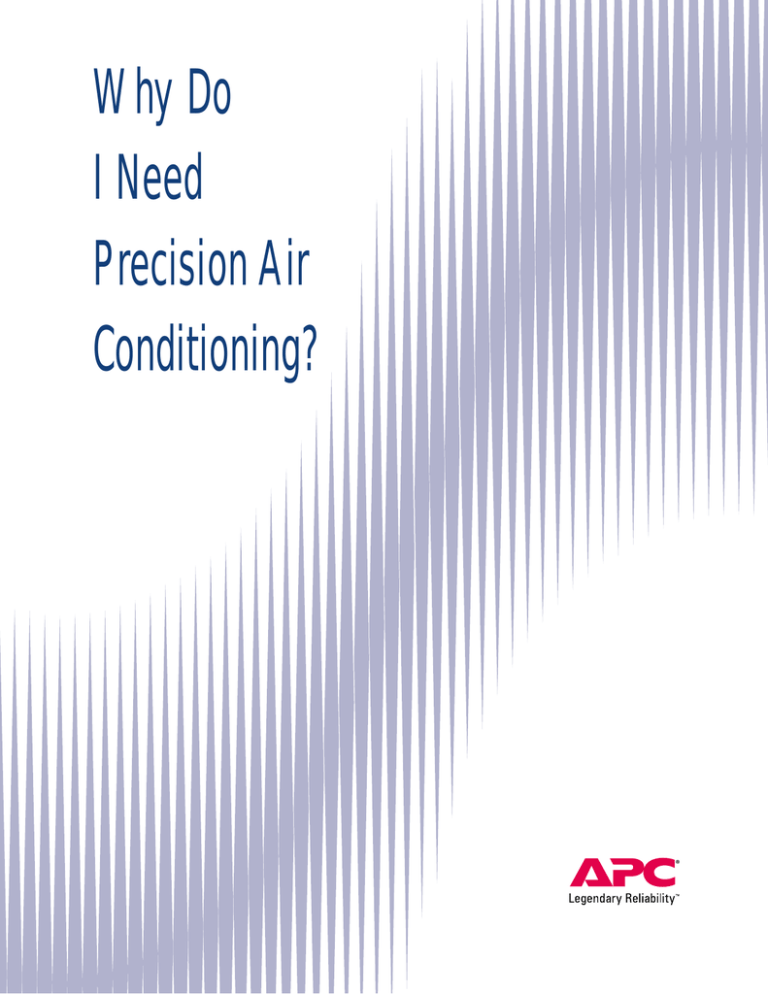
Why Do
I Need
Precision Air
Conditioning?
Executive Summary
Today's technology rooms require precise, stable environments in order for sensitive electronics to
operate optimally. Standard comfort air conditioning is ill suited for technology rooms, leading to system
shutdowns and component failures. Because precision air conditioning maintains temperature and
humidity within a very narrow range, it provides the environmental stability required by sensitive
electronic equipment, allowing your business to avoid expensive downtime.
Defining Today’s Technology Rooms Not Just Computer Rooms Anymore
Precision environmental control requirements now reach far beyond the confines of the traditional data center or
computer room to encompass a larger suite of applications, referred to as “Technology Rooms”.
Typical technology room applications include:
1- Medical equipment suites (MRI, CAT scan)
2- Clean rooms
3- Laboratories
4- Printer/copier/CAD centers
5- Server Rooms
6- Hospital facilities (operating, isolation rooms)
7- Telecommunications (switch gear rooms, cell sites)
One of the highest growth application areas is telecommunications, including a wide range of facilities from
simple remote switch stations to complex central exchange centers.
Why Do I Need Precision Air Conditioning?
Because information processing is the lifeblood of all critical operations, reliability in your technology room is vital
to your company's health. IT hardware produces an unusual, concentrated heat load, and at the same time, is very
sensitive to changes in temperature or humidity.
A temperature and/or humidity swing can produce problems ranging from processed “gibberish” to a complete
system shutdown. This can create huge costs for the company, depending on the length of the interruption and
the value of time and data lost.
Standard comfort air conditioning is not designed to handle the heat load concentration and heat load profile of
technology rooms, nor is it designed to provide the precise temperature and humidity set point required for these
applications.
Precision air systems are designed for close temperature and humidity control. They provide high reliability for
year-round operation, with the ease of service, system flexibility and redundancy necessary to keep the
technology room up and running 24 hours a day.
4
©2001 American Power Conversion. All rights reserved. No part of this publication may be used, reproduced, photocopied, transmitted, or stored
in any retrieval system of any nature, without the written permission of the copyright owner. Part# 996-2319A. www.apc.com
Temperature and Humidity Design Conditions
The maintenance of the temperature and humidity design conditions is critical to the smooth operation of a
technology room. Design conditions should be 72-75°F and 45-50% relative humidity (R.H.). As damaging as the
wrong ambient conditions can be, rapid temperature swings can also have a negative effect on hardware
operation. This is one of the reasons hardware is left powered up, even when not processing data. Precision air conditioning is designed to maintain temperature at ±1°F and humidity at ±3-5% R.H. 24 hours a day, 8760 hours a year.
In contrast, comfort systems are designed to maintain 80°F and 50% R.H. only during summer conditions of 95°F
and 48% R.H. outside conditions. There is usually no dedicated humidity control and the simple controllers
cannot maintain the set point tolerance required for temperature, allowing potentially harmful temperature and
humidity swings to occur.
Problems Caused by the Wrong Environment
A poorly maintained technology room environment will have a negative impact on data processing operations.
The results can range from data corruption (gibberish) to complete system shutdowns and failures.
1- High & Low Temperature
A high or low ambient temperature or rapid temperature swings can corrupt data processing and shut down an
entire system. Temperature variations can alter the electrical and physical characteristics of electronic chips and
other board components, causing faulty operation or failure. These problems may be transient or may last for
days. Even transient problems can be very difficult to diagnose and repair.
2- High Humidity
High humidity can result in tape and surface deterioration, head crashes, condensation, corrosion, paper
handling problems, and gold and silver migration leading to component and board failure.
3- Low Humidity
Low humidity greatly increases the possibility of static electric discharges. Such static discharges can corrupt
data and damage hardware.
5
©2001 American Power Conversion. All rights reserved. No part of this publication may be used, reproduced, photocopied, transmitted, or stored
in any retrieval system of any nature, without the written permission of the copyright owner. Part# 996-2319A. www.apc.com
Differences Between Precision Air
and Comfort Air Conditioning
1- Sensible Heat Ratio
A heat load has two separate components: sensible heat and latent heat. Sensible heat is the increase or
decrease in air-dry bulb temperature. Latent heat is the increase or decrease in the moisture content of the air.
The total cooling capacity of an air conditioner is the sum of the sensible heat removed and the latent heat
removed.
Total Cooling Capacity = Sensible Cooling + Latent Cooling
The Sensible Heat Ratio is the percentage of the total cooling that is sensible.
Sensible Heat Ratio (SHR) =
Sensible Cooling
Total Cooling
In a technology room, the cooling load is made up almost entirely of sensible heat coming from IT
hardware, lights, support equipment, and motors. There is very little latent load since there are few
people, limited outside air, and usually a vapor barrier. The required SHR of an air conditioner to match
this heat load profile is very high, 0.95-0.99. Precision air conditioning is designed to meet these very high
sensible heat ratios.
In contrast, a comfort air conditioner typically has a SHR of 0.65-0.70, and provides too little sensible cooling
and too much latent cooling. The excess latent cooling means that too much moisture is continually being
removed from the air and an energy-expensive humidifier is required to replace moisture.
Sensible Heat Ratio (SHR)
Precision Air
Conditioning
.95 - .99 SHR
Comfort Air
Conditioning
.70 - .65 SHR
0.0
0.2
0.4
0.6
0.8
1.0
Figure 1: Sensible Heat Ratio
6
©2001 American Power Conversion. All rights reserved. No part of this publication may be used, reproduced, photocopied, transmitted, or stored
in any retrieval system of any nature, without the written permission of the copyright owner. Part# 996-2319A. www.apc.com
2- Precise Temperature and Humidity
Precision air conditioners have the sophisticated, fast-acting, microprocessor-based controls necessary to react
quickly to changing conditions and maintain the tight tolerances required for a stable environment. Precision
air systems usually include multiple stages of cooling and heating, a humidifier, and a dedicated
dehumidification cycle, allowing them to satisfy any and all temperature and humidity control requirements.
Comfort air conditioners generally have basic, limited controls unable to react quickly enough to maintain the
required tolerance. Comfort systems do not usually include heat or the humidification/dehumidification cycles
necessary for a stable technological environment. The components, if available, are frequently “add ons” and
not part of an integrated system.
3- Air Quality
Precision air conditioners operate at a high CFM, 600-1000 CFM/ton. This high CFM moves more air through the
space improving air distribution and reducing the chance of localized hot spots. It also allows more air to move
through filters, ensuring a cleaner environment. Precision air conditioners typically use a moderate- to
high-efficiency filter bank, deep-pleated, to minimize airborne particles.
Comfort air conditioners operate at a much lower CFM, 300-400 CFM/ton. Low CRMs can lead to poor air
distribution and more airborne contaminants. Filters for comfort air conditioners are usually flat, low-efficiency
media that do not remove a sufficient percentage of airborne particles.
4- Hours of Operation
Precision air conditioners are designed and built to run non-stop 8760 hours a year. The systems are
designed - with components selected and redundancy incorporated - to ensure zero downtime. System
controls maintain room conditions for the full range of outside ambient conditions, summer or winter.
Comfort air conditioners are designed to run during summer days, up to an expected maximum of 1200 hours
per year. The system is not designed or expected to operate non-stop, year round. Neither the controls nor the
refrigeration system is designed for zero downtime or winter operation.
Design Criteria
Office Area
1- Load Density
Technology Room
Due to the high equipment concentration, the load
density within a technology room can be five times
higher than that in a typical office. Systems must
be designed to handle this extremely high-density
load. Sensible capacity and air distribution are
very important.
Figure 2: Load Density
Load Density
Office
250-300 sq. ft./ton
Technology Room
25-30 sq. ft./ton
7
©2001 American Power Conversion. All rights reserved. No part of this publication may be used, reproduced, photocopied, transmitted, or stored
in any retrieval system of any nature, without the written permission of the copyright owner. Part# 996-2319A. www.apc.com
2- Temperature and Humidity
Design goal conditions should be 72-75 degrees F, 45-50% R.H.
3- Air Quantity
Precision air systems are designed for a high CFM, 600-1000 per ton. This contributes to the high sensible heat
ratio, improves air distribution, and increases filtration rates. The high CFM does not cause discomfort to
personnel as it is distributed under the raised floor and drawn up through equipment and into the space around
the room.
4- Air Cleanliness
Without filters, airborne dust can damage equipment. Filters should be deep pleated for moderate to high
efficiency. Filter sizing is also important; the filter must operate with face velocities low enough to be effective.
Regular filter changes are necessary.
5- Air Distribution Methods
With comfort air conditioning systems, the room air is usually distributed through the overhead ducts. To
provide the best airflow in technology rooms, air should be supplied through perforated tiles in a raised floor.
a- Under-floor System (Recommended)
Most computer hardware is designed to take air in at the front of the unit and let it out through the
back of the unit. The precision air conditioner takes warm room air in at the top and delivers cool air
through the floor permitting higher air quantities without disturbing the occupants.
Modern technology rooms use a raised floor with a minimum clearance height of 9” (preferably 12 to
18”) to serve as a cable raceway and act as an ideal air distribution plenum.
Under-floor System
Overhead System
Air conditioner
Air conditioner
CPU
CPU
Floor
Floor
Figure 4: Overhead System
Figure 3: Under-floor System
Frequently, motors and blowers will also need to
be up-sized to handle the additional static losses
presented by the ductwork.
8
©2001 American Power Conversion. All rights reserved. No part of this publication may be used, reproduced, photocopied, transmitted, or stored
in any retrieval system of any nature, without the written permission of the copyright owner. Part# 996-2319A. www.apc.com
b- Overhead System (Recommended for small room applications only)
Overhead systems discharge air into either a plenum or ductwork. These units are suited for areas
where raised floors are less than 12" high. The precision air conditioner takes warm room air in
through the front of the unit and delivers cool air through a plenum connected to the top of the unit
and back down over the equipment. Considerable turbulence exists at upper air levels due to
conflicting air streams from the IT equipment. The overhead system is not recommended in large
room applications because the uneven distribution of cool air heightens as space increases, resulting
in hot spots and cold spots.
A further problem with overhead ducts is their inflexibility to meet changes in hardware location,
resulting in hot spots and cold spots that are often impossible or extremely expensive to remedy.
6- Vapor Barrier
Because almost all construction materials are transparent to moisture, a well-designed technology room must
include a vapor barrier. Without a vapor barrier, the technology room will lose humidity in the winter and will
gain it in the summer. This makes humidity set point control very difficult and increases the run times of
energy-expensive compressors and humidifiers.
To create an effective vapor barrier, ceilings should be sealed with a polyethylene film, concrete walls should
be painted with a rubber or plastic base paint, doors should seal tightly, and all pipes and cable penetrations
should be sealed.
7- Outside Air Requirements
Technology rooms tend to be sparsely populated and do not require much outside air for personnel. Outside
air should be minimized to limit the latent load brought into the room. A quantity of 20 CFM per person is
currently sufficient to satisfy Indoor Air Quality (IAQ) concerns in the U.S.
8- Redundancy
Redundancy is achieved by operating additional equipment to provide 100% of the required cooling capacity
even after a unit shutdown or failure. The cost of redundancy should be weighed against the projected cost of
technology room downtime.
15 Ton
15 Ton
Handles the 30 ton load
15 Ton
Redundant Unit
20 Ton
20 Ton
40 ton capacity is 10 ton overload
Figure 5: Redundancy
The difference between redundancy and over capacity should be noted. A 20-ton load with 3 x 15 ton systems
or 4 x 10 ton systems provides redundancy. A run-time-based rotation of equipment operation and a controls
interface that provides automatic start up are required for standby equipment to be considered redundant.
9- Security
The security of the air conditioners is as important as that of the technology room hardware since the hardware
cannot operate without them. The indoor units must be located within the technology room and should be
subject to the same restricted access as the IT hardware. The outside heat rejection equipment should be placed
on a roof or some other secure area within the facility.
9
©2001 American Power Conversion. All rights reserved. No part of this publication may be used, reproduced, photocopied, transmitted, or stored
in any retrieval system of any nature, without the written permission of the copyright owner. Part# 996-2319A. www.apc.com
System Selection Factors
1- Load Calculations
Heat in technology rooms is generated by hardware, lights, people, outside air, transmission loads, sun, and
support equipment (PDU’s, UPS, etc.).
As a rule of thumb, use 50 sq. ft./ton for load calculations. For a more detailed load calculation use the
following form. After calculating the sensible load be sure to add in the following:
• Safety factor
• Growth factor
• Redundancy
It is important to remember to select systems based on sensible capacity. Check with the air conditioning
manufacturer that cataloged net cooling capacities have been calculated to include motor heat. Motor heat must
be considered as part of the room's heat load.
Room Conditions
Outside-Summer
Outside-Winter
Air Conditioning Load Calculation Form
°F
°F db
°F db
Heat Source
Base Data
Factor
Hardware
Hardware may be rated in BTU/hr directly:
or if rated in kw, multiply kw by factor of 3400
or if rated in kva, multiply kva by .9 then by 3400
Lights
Area in sq. ft.
Transmission: Walls
Surface area
x 0.15 x temp diff across wall
Transmission: Ceiling
Surface area
x 0.20 x temp diff of
°=
x
1
Transmission: Floor
Surface area
x 0.30 x temp diff of
°=
x
1
Sun on glass surface
Surface area
x 100 =
Sun on roof
Surface area
x 0.80 x temp diff of 78° =
People
Number of people =
Outside Air
Number of people
Motors in A/C Units
Use 10% of “Hardware” BTU/hr (verify with A/C supplier if
their ratings include the motor heat, or add heat to room load).
x 2 watts per sq. ft.=
BTU/hr
kw x
kva x
x
BTU/hr
1
3400
3060
3.4
°=
x
x
1
1
x
1
x
x 7.5 cfm/per x 1.08 x
%RH
°F wb
°F wb
250
°td =
x
1
This load should be the basis of selecting modular air conditioners using their “sensible heat” capacities. The number of units needed = Total Sensible Load/Sensible capacity of the cataloged air Total “Sensible” Load =
conditioner. Add one or two more conditioners for redundancy. Does this load allow for growth?
Figure 6: Calculation Form
10
©2001 American Power Conversion. All rights reserved. No part of this publication may be used, reproduced, photocopied, transmitted, or stored
in any retrieval system of any nature, without the written permission of the copyright owner. Part# 996-2319A. www.apc.com
2- Unitary Systems
a- Air Cooled
Air Cooled Condenser
Air Conditioner
Figure 7: Air Cooled System
System configuration
• Refrigeration system is “split” between indoor air conditioner and outdoor air-cooled heat
rejection unit.
• Compressors can be located in the indoor or outdoor equipment. For security and maintenance,
compressors are usually located in the indoor unit.
• Refrigerant pipelines (two per compressor) interconnect two halves of the system.
• Refrigerant piping design is critical. The design must address pressure losses, refrigerant velocities, oil
return, and traps.
• Qualified expert contractors should install the service unit.
• Excellent for multiple units and expanding installations. Each system is a self-contained,
stand-alone module.
Cooling Tower
b- Water Cooled
Air Conditioner
Pump Package
System configuration
Figure 8: Water Cooled System
• Indoor air conditioner is a complete, self-contained refrigeration system.
• Heat is rejected to a coolant water supply via a heat exchanger in the indoor unit. The coolant water is
then usually pumped to a cooling tower and re-circulated. Other water sources such as wells
also can be used.
• Cooling tower should be winterized in cold and temperate climates.
• Tower should be designed with redundancy, or an emergency back-up water supply should be available.
• Water treatment is required when a cooling tower is used.
• Water pipe design is a lot less critical and easier to install than refrigerant piping.
• The refrigeration system arrives factory charged and tested.
11
©2001 American Power Conversion. All rights reserved. No part of this publication may be used, reproduced, photocopied, transmitted, or stored
in any retrieval system of any nature, without the written permission of the copyright owner. Part# 996-2319A. www.apc.com
c- Glycol Cooled
Air Conditioner
Dry Cooler
Pump Package
Figure 9: Glycol Cooled System
System configuration
• Indoor unit is similar to water-cooled system.
• A glycol solution is circulated in place of water and the heat rejection occurs in an outdoor liquid to
air heat exchanger or "dry cooler.”
• Dry coolers are lower maintenance than cooling towers.
• Presents excellent opportunities for heat recovery application.
• System E.E.R. is lowest of three unit types.
• Multiple units can be linked to single large dry coolers and pump packages. Be aware of redundancy
requirements if this is done.
d- Free-cooling Glycol
System configuration
• Product is identical to glycol-cooled but also includes an additional free-cool coil for energy savings.
• When the outside temperature drops, cool glycol solution is run through the supplementary
free-cool coil and cooling is obtained without running the compressors.
• Presents excellent operating cost reductions in appropriate climates.
• Extra coil means more blower motor HP.
• Look for systems with larger free-cool coils for more cost savings. Free-cool coils should be installed
before the DX coil for assisted capacity during mild, ambient temperatures.
e- Supplementary Chilled-water Coil
System configuration
• A supplementary chilled-water coil can be included in a DX system to provided complete
redundancy in a single unit.
• Unit may operate as a chilled water system with 100% modular DX back up in the event of
an emergency.
• Unit may act as a DX system with emergency central plant chilled-water back up if required.
• Unit may use chilled water when available. For instance, if chiller runs primarily to support a
manufacturing process in a factory or to support summertime comfort systems, and switch to DX
when chilled water is routinely no longer available.
12
©2001 American Power Conversion. All rights reserved. No part of this publication may be used, reproduced, photocopied, transmitted, or stored
in any retrieval system of any nature, without the written permission of the copyright owner. Part# 996-2319A. www.apc.com
f- Chilled Water
Air Conditioner
Central Chiller
System configuration
Figure 10: Chilled Water System
• Chilled water is supplied from a central chiller to packaged units in the technology room.
The refrigeration system is contained in the packaged chiller.
• Indoor air conditioners contain controls, chilled-water coil, chilled-water control valve, blowers,
filters, humidifiers and reheat.
• Chilled-water temperature should be as high as possible to keep a high sensible heat ratio
(47°F or higher).
• Redundancy should be extended to central chilled plant and pump packages.
• Central plant should be winterized for year-round operation.
• May require operating personnel in some cities.
• Do not combine with comfort cooling chillers since chilled-water supply temperatures should differ
(42°F comfort, 47°F+ for technology room).
Cost of Ownership
1- Operating Costs
Technology room air conditioning costs are typically ten times higher per square foot than office or comfort air
conditioning. This is because of year-round instead of seasonal operation and the greatly increased heat load
density. However, precision air conditioning operating costs are far less than comfort air conditioning if both
systems are applied to a technology room.
Precision air conditioning costs are lower than comfort air conditioning for comparable use because
of the following:
a- Under-floor System - A high sensible heat ratio eliminates over-dehumidification and subsequent
humidifier operation.
b- High Energy Efficiency Ratio (E.E.R). With the oversized coils, high CFM, and heat pump duty
compressors, computer grade systems have higher sensible cooling energy efficiency ratios than
conventional comfort cooling.
13
©2001 American Power Conversion. All rights reserved. No part of this publication may be used, reproduced, photocopied, transmitted, or stored
in any retrieval system of any nature, without the written permission of the copyright owner. Part# 996-2319A. www.apc.com
c- Precision air equipment is designed with high-efficiency components for year-round operation.
Look for the following:
• Oversized, shallow cooling coil
• High efficiency blower motors
• Steam canister humidifiers
• Heat pump duty rated compressor
• High S.H.R.’s
• Dedicated dehumidification cycle
• Low FLA
20
• 100,000 HR L rated bearings
• Extended warranties
2- Service Costs
The largest costs incurred during the service or repair are generally in technology room downtime. For this
reason, redundancy should always be designed in first. However, to further reduce this exposure, equipment can
be selected with features that will reduce required service and repair time dramatically. Look for the following:
a- Bolt in refrigeration components. Compressor and filter dryer should be removable without
gas torches.
b- Primary and secondary engineering drain pans.
c- Quick-change canister humidifier.
d- Components should be out of the air stream in a separate mechanical section.
e- Removable fan deck assembly.
f- Color-coded and numbered electrical wiring.
g- Motor start protectors instead of fuses.
h- Easily removable and/or hinged access panels.
I- Run-time-based maintenance calls.
Conclusions
Technology rooms house sensitive electronics that need precise environmental conditions to run optimally. By
providing the environmental stability that this type of electronic equipment requires, precision air conditioning
helps your business avoid expensive system shutdowns and component failures.
14
©2001 American Power Conversion. All rights reserved. No part of this publication may be used, reproduced, photocopied, transmitted, or stored
in any retrieval system of any nature, without the written permission of the copyright owner. Part# 996-2319A. www.apc.com

